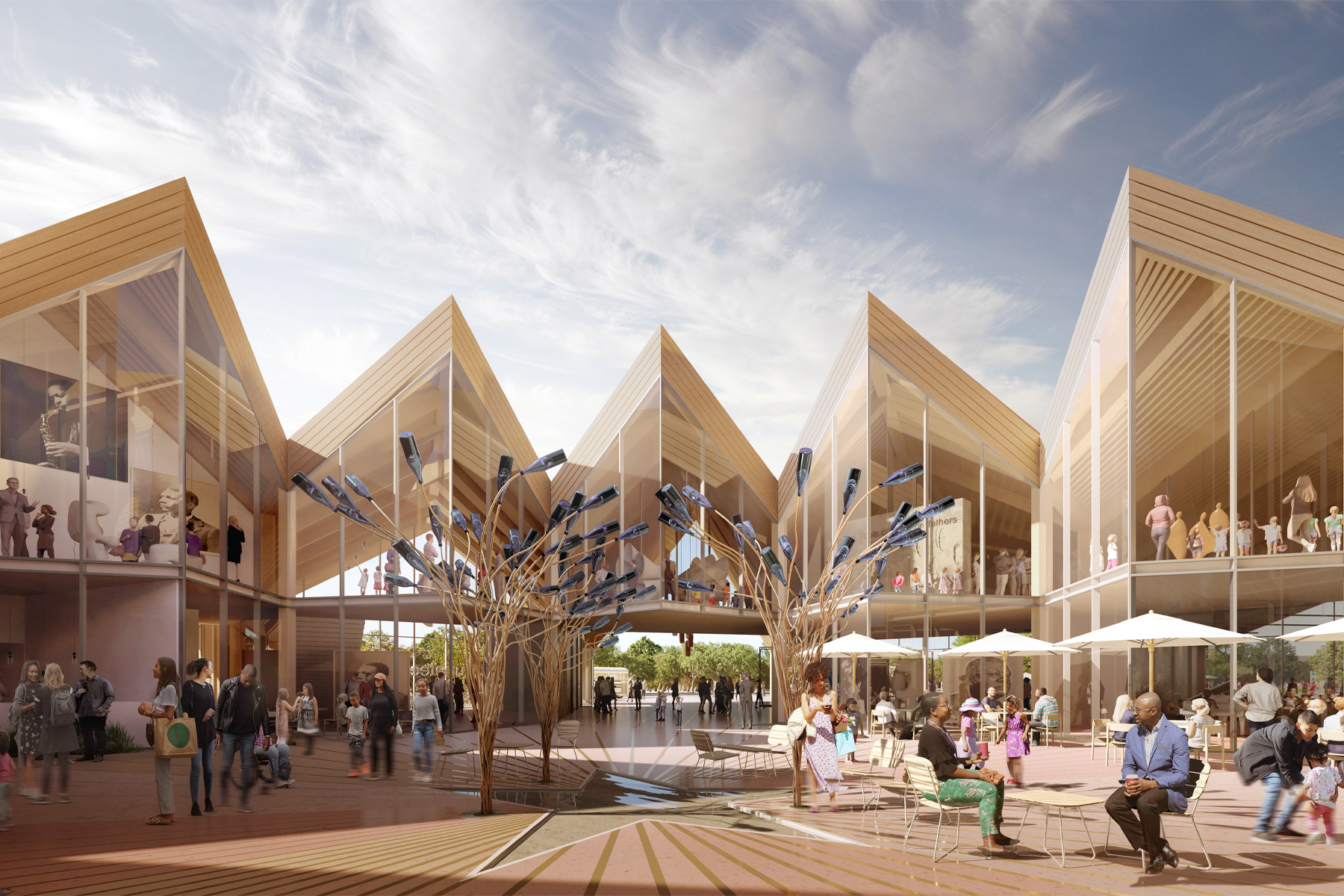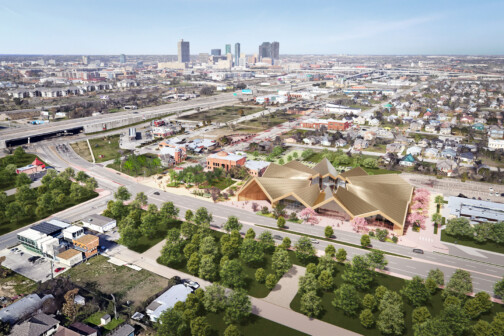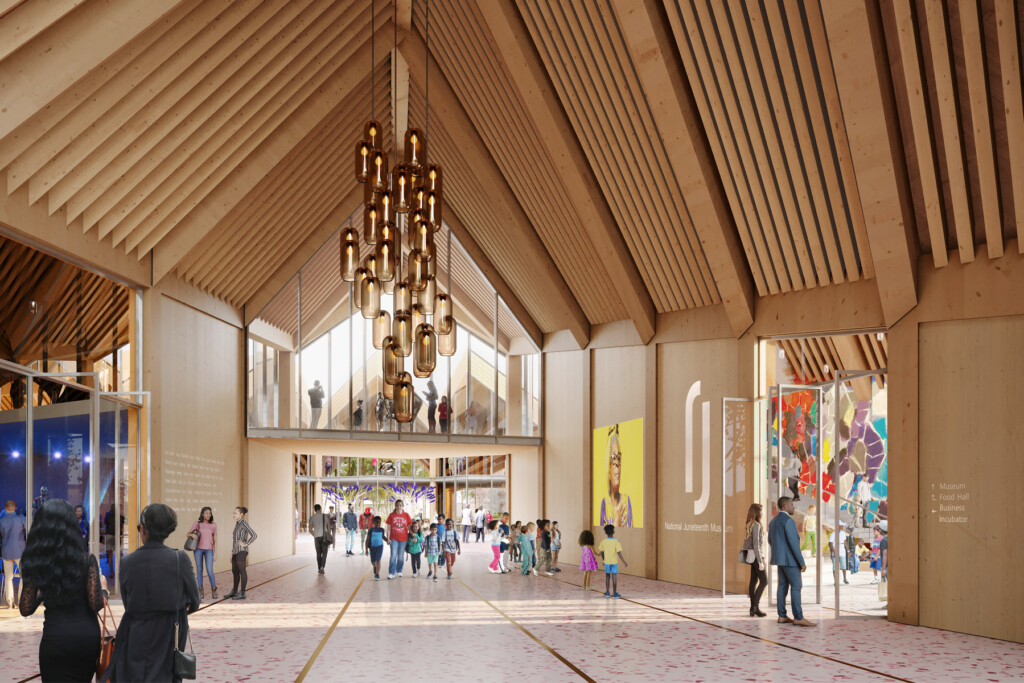Sitting in the living room of Opal Lee’s Fort Worth home, I count three people who walk in unannounced during the course of my interview. The thought of neighbors entering your home without an invitation may be unsettling, but Lee, the “Grandmother of Juneteenth,” has dedicated her entire life to welcoming in others. Dione Sims, Lee’s granddaughter, puts it best: “I think her lifelong passion is to make sure that everybody in the world is taken care of.”
Continuing the story of Lee and the holiday she made federal, members of the National Juneteenth Museum board recently broke ground for their new complex, which is scheduled to open on June 19, 2025. Not only will it educate visitors about the history of Juneteenth, but it will also serve as an economic engine to boost the surrounding Historic Southside neighborhood of Fort Worth.
Designed by the Bjarke Ingels Group, the 50,000-square-foot facility will sit on land previously occupied by the old Juneteenth Museum, a one-story house that was lost to a fire in January, on the corner of East Rosedale Street and Evans Avenue. Its gabled roof will mimic those of the shotgun-style houses in the neighborhood, and its signature design feature will be an open courtyard at its center, around which the roofing will undulate.
When viewed from overhead, the inside tips of the gables will form the outline of a 12-point star, also known as a nova or “new” star. In the middle of the courtyard there will be a five-point star engraved into terrazzo pavement. The two stars combined form the centerpiece of the Juneteenth flag.
Inside the museum, there will be 10,000 square feet for permanent, immersive galleries and a “black box” space designated for traveling exhibits. Sims, who is a part of the museum’s curation team, says she has already been in communication with other sites, such as the National Abolition Hall of Fame and Museum, about showcasing items from their collections.
Lee credits much of the expanded vision for the new museum to Jarred Howard, who was announced as the CEO in April. In 2018, Lee had approached Fort Worth’s Chamber of Commerce to request funding for Juneteenth festivities. When the chamber’s financial position prevented it from meeting her request, it sent Howard, one of its executives, to break the bad news to Lee. During their conversation, she asked him about his personal visions and goals.
“I told her that I really wanted to develop this mixed-use development on the Historic Southside of Fort Worth that would represent the rebirth of Black culture in the city and in that neighborhood in particular,” Howard says. “If you were to rewind the clock, you would see that Black culture in the city was born in that neighborhood.”
“The core of the museum is this ecosystem that is cultivating excellence and opportunity.”
Lee says, “He began to tell me about all the things he wanted to do just as soon as he phoned, and it took off like a rocket. He had such wonderful ideas, and it never occurred to me that it could be more than what it was down there, which wasn’t much at all.”
The 76104 ZIP code, which includes the Historic Southside, has not fared well financially or medically. Census Bureau data show that from 2017 to 2021, the area’s median household income stood just under $42,000, more than $26,000 below Fort Worth’s median. A 2019 UT Southwestern study showed that the ZIP code held the lowest average life expectancy in Texas at 66.7 years, 12 years below Tarrant County’s average.
The neighborhood wasn’t always like this. Both Sims and Howard cite William Madison “Gooseneck” McDonald, widely considered to be Texas’ first Black millionaire, as a central figure in expanding opportunities for Black Fort Worth residents in the early 1900s. According to the Tarrant County Black History and Genealogical Society, after moving to the Southside around 1906, McDonald founded Fort Worth’s first Black-owned bank, Fraternal Bank and Trust Company, located inside the Masonic Temple downtown.

By 1928, the bank had more than 1,000 depositors and cash flow exceeded $800,000, allowing McDonald to lend to local Black entrepreneurs previously rejected by White banks. Ironically, many of these same White banks acquired loans from Fraternal Bank and Trust to survive the Great Depression.
McDonald attended foreclosure auctions on the Tarrant County Courthouse steps to add to his sizable portfolio of Southside houses. He then helped Black residents qualify for mortgages. In the late 1920s, he built the three-story, 50-room Jim Hotel located along East Fifth Street. Named after his then-wife Jimmie Strickland, the inn was featured in the Green Book as a safe spot for Black travelers. Under different Black ownership in the 1930s, the hotel became the city’s Black music hub as jazz legends such as Louis Armstrong and Ella Fitzgerald graced its clubroom.
During the same decade, a significant portion of what is now 76104 and almost the entirety of the Historic Southside were redlined. Then, around 1960, construction of I-35W compounded issues when it sliced the neighborhood in two vertically, dividing families, friends, and schools and cutting off much of the area from vital resources.
“There’s both a physical and a psychological barrier between the Historic Southside and the Near Southside,” Howard says. “The socioeconomics of each could not be more distinctive. You don’t have to do anything more than to stand under the bridge at I-35 and look west. You see lots of activity. You see cranes. You see a dense population. You look east, you see desolation and destitution.”
Fast-forward to 2025, and the National Juneteenth Museum will offer multiple in-house resources to reestablish McDonald’s mission. It will contain a 250-seat theater for aspiring artists to hone their crafts, a food hall for chefs and vendors to showcase their talents, and a business incubator that will give young entrepreneurs an affordable space where they can work in a collaborative environment. The hope is for the incubator to also offer night classes to aspiring business owners who work 9 to 5 and workshops for those without degrees looking to join trades.
“The core of the museum is this ecosystem that is cultivating excellence and opportunity in a place that the data points say you’re not supposed to make it,” says Wil Murphy, vice president of marketing and PR at K Strategies, the agency that represents the museum. “We’re changing that narrative.”
For Lee, the museum is a culmination of her dream to educate the country and the world about Juneteenth. “It’s about freedom for everybody, and we’re not free yet,” she says. “There’s so much more that has to be done. As long as we have homelessness, and joblessness, and healthcare that some people can get and others can’t, and climate change that we’re responsible for, we’re not free. It just behooves us to work together to get rid of these disparities. That’s freedom, and I hope it happens in my life.”

What Is Juneteenth?
It is one of only five date-specific federal holidays.
The Juneteenth holiday recognizes Union Major-General Gordon Granger’s arrival in Galveston on June 19, 1865, to declare the freedom of slaves in Texas, one of the last places to receive the news, more than two years after the Emancipation Proclamation. Rather than focus on that day in Galveston, however, exhibits at the National Juneteenth Museum will cover historical events and individuals nationwide, from Northern Quakers and abolitionists to the southbound Underground Railroad that led into Mexico. By highlighting the diversity of those who fought for emancipation, Sims hopes any visitor of any background can relate to the central message of freedom. “Our goal is for everybody to see themselves in the story of Juneteenth,” she says.
This story originally appeared in the June issue of D Magazine with the headline, “Freedom and Light” Write to [email protected].






